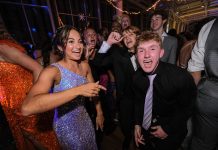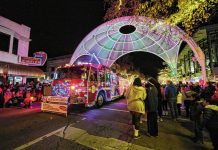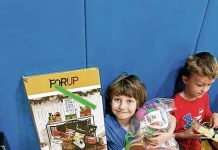Cancer free.
Just two words strung together, the term has the power to change lives. Just ask 13-year-old Alana Cook of Columbus.
After Alana went through six months of radiation and chemotherapy to treat a papillary tumor, a rare and malignant form of brain cancer, a magnetic resonance imagine (MRI) test on July 7 came back showing no evidence of disease, or NED. It’s the medical term commonly used to describe a cancer that is in remission.
When her doctors explained the test results, “cancer free” was the only thing Alana recalls hearing.
[sc:text-divider text-divider-title=”Story continues below gallery” ]
“I think I was in shock,” Alana said of hearing the news. “(My mom), of course, was crying.”
For Holly Cook, Alana’s mother, tears were a natural response to months of worry, treatment and separation from friends and family coming to an end.
The life of the Cook family — which includes Alana, her mom and her dad, Alan — was dramatically changed by Alana’s diagnosis, which forced them to relocate to Chicago in the winter for radiation therapy, then return to Indiana so Alana could receive five rounds of chemotherapy at Riley Hospital for Children at IU Health in the spring.
The Cooks were required to spend three days at the hospital in Indianapolis every time Alana underwent a round of chemotherapy, which was administered every 21 days.
At times Alana said she did feel nauseous, but other standard afflictions that often accompany chemotherapy evaded her. No fevers, no infections, no blood transfusions.
“She set the bar high,” Holly Cook said.
Athletic treatment regimen
As a star middle school athlete on the basketball court, Alana’s doctors wanted to put her on a treatment regimen that would have the lowest possible effect on her athletic ability, especially her heart health. So she was put on the same treatment plan that cyclist Lance Armstrong followed in his own battle against cancer in the 1990s.Alana’s response to chemotherapy rivaled that of a professional athlete, Holly Cook said. Her daughter’s impressive response to the treatment helped to put her at ease and was often the source of her own strength as she tried to support her through the treatment process.
Although she was initially set to receive six rounds of chemotherapy, Alana said both she and her doctors agreed that if five rounds were not enough to stop the cancer, then a sixth round would make little difference.
She received her final treatment in May, had her central line removed in June and returned to Riley for a brain scan on July 7. The scan was meant to determine if a cystic lesion found on her brain had grown, a sign that would likely mean the lesion was actually a tumor.
But when the results came in, not only had the cystic lesion not grown, it had shrunk, an all-but-certain sign that it is not a tumor. With those results in hand, the doctors at Riley determined that the original tumor that was surgically removed last fall had not grown, which led to the cancer-free declaration.
“The nurse that gave me the bad news that I had cancer also gave me the good news,” Alana said.
Looking to the future
Reflecting over the past nine months, Alana said she can hardly believe it has almost been a full year since her diagnosis.But rather than focusing on the struggles from the past year, the 13-year-old said her sights are set on the future.
On Wednesday, Alana will return to school full-time for the first time since her diagnosis last fall.
Once she began treatment in November, the Northside Middle School seventh grader was forced to do school work at home. Her teachers would collect her homework and drop it off, and then Alana would work through the assignments and turn them back in as she was able.
Keeping up with her school work remotely was difficult at times, especially when it came to math, Alana said. But the school agreed to grade her on a pass/fail basis, rather than based on a standard A to F scale, which enabled her to pass her classes and stay on the same academic level as the rest of her peers.
“We focused on quality, not quantity,” Alana’s mother said.
As she prepares to return to school full-time for eighth grade, Alana said she is most looking forward to getting to spend time with her friends during the school day like she did before she was diagnosed.
But the teen’s social life stayed largely intact even as she was out of town receiving treatment.
When Alana was back home in Columbus, the Cook house was generally filled with a constant rotation of visitors. And if she was feeling up to it, Alana would venture out to visit her friends, sometimes at their homes, sometimes during short visits to school and sometimes at her favorite place in the world — the basketball court.
Alana’s cancer diagnosis brought her regular participation with the Comets basketball team temporarily to an end, but the star athlete said she continued to hone her skills on her home court during treatment.
In the midst of her chemotherapy, Alana even found her way back onto the court with the rest of her Comets teammates at a game in April.
After the coach made the decision to let her sub in, Alana’s return to basketball made it seem as if she had never taken a break from the sport. She took control of the ball, made her way down the court and, in a move that made the crowd erupt in cheers, scored a basket for her team.
“It felt pretty good,” she said.
Not only does Alana plan to return to the Comets team — which combines players from Northside and Central middle schools — this year, she also plans on playing for Northside’s eighth grade team.
Although the return to an intense physical regimen might initially be difficult, Alana said she is confident she will be able to reclaim her place on the basketball court and fall back into a familiar routine with her teammates.
Fall break hopes
Aside from school activities, Alana and the Cook family also are looking forward to taking a trip out of town that won’t require a hospital stay.Through the Make A Wish Foundation, Alana has applied for a fall break trip to Oahu, Hawaii, in October. The trip is still in the approval phases, but if the family gets the go-ahead, Alana said she plans to go deep-sea fishing, volcano exploring and whale watching, among other things.
Many youth choose to use their Make-A-Wish trip to visit Disney World, but the 13-year-old said she wanted to explore some place a little bit more unique.
The fall break trip would coincide with both the one-year anniversary of her diagnosis and her first scheduled return to the doctor for a follow-up brain scan, a process Alana must undergo every three months to monitor her progress and ensure the cancer does not come back.
Right now, Holly Cook said her goal is to help her daughter stay cancer-free for the next five years, a milestone that generally indicates a treated cancer will not return. After five years, Alana’s doctors also have a 10-year remission plan, Cook said.
But even as Alana’s health improve, the Cooks said they are constantly reminded of other children they have met along their journey who have not been as fortunate as the Columbus teen.
“It’s the other kids we’ve picked up and the families we met in Chicago,” Holly Cook said. “You wanna celebrate, but you also have that guilt.”
That’s why, as Alana continues to return to the doctor for brain scans every three months, the Cook family said they will continue to be there to support the other families they have met along the way.
Alana said she wants to use her story and experiences to advocate for other children who are still in the deepest trenches of their cancer battles.
[sc:pullout-title pullout-title=”Cancer/treatment timeline” ][sc:pullout-text-begin]
Oct. 3, 2015: Alana is hit in the head during a game of dodge ball and begins suffering from extreme headaches and fatigue.
Month of October: Alana and her mother Holly spend nearly every other day in the pediatrician’s office trying to diagnose her illness. Doctors at Riley Hospital for Children find a brain tumor and insert a shunt into her brain to release fluid. Late in the month, Alana is diagnosed with choroid plexus carcinoma, a malignant tumor.
Oct. 29: Later that day, she informs her Columbus Comets basketball teammates of the diagnosis.
Nov. 4: Doctors at Riley complete a seven-hour operation to remove the tumor.
Nov. 12: Alana’s diagnosis changes to a papillary tumor, a rare form of brain cancer.
Late fall: Several fundraisers are organized to help the Cooks pay for Alana’s medical expenses. The Original Party Mart in Columbus baked and sold about 5,500 sugar cookies, decorated with the #COOKIESTRONG logo that has become the symbol of Alana’s journey to health. Proceeds from meals at Chipotle Mexican Grill also go the the family. And on Dec. 12, a family friend hosted “Alana’s Day” at Northside Middle School, with music, chili and pizza accompanied by a free-will offering. T-shirt sales are also held. Thousands of dollars are raised.
Dec. 7: Alana receives her first proton radiation therapy treatmentas the Cook family relocates to Chicago for roughly eight weeks for the treatment.
Jan. 22, 2016: Alana completes her 33rd round of radiation therapy and returns to Columbus.
Feb. 11: Alana’s central line for chemotherapy is placed in her body.
March – May: Alana undergoes five rounds of chemotherapy — one treatment every 21 days — at Riley. She is required to stay in the hospital three days for each round.
July 7: An MRI shows that the cystic legion on her brain has shrunk, rather than grown. Her doctors declare her cancer-free.
October: Alana will undergo another brain scan to monitor her progress. She will get a brain scan every three months.
[sc:pullout-text-end]




